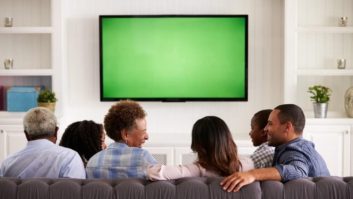
The annual International Consumer Electronics Show (CES) draws to a close in Las Vegas today, having provided a showcase for 3,600 exhibitors, including manufacturers, developers and suppliers of consumer technology hardware, content, technology delivery systems; a conference programme with 250 sessions; and hosted in the region of 160,000 attendees from more than 140 countries.
The event’s primary focus is on consumer technologies, with products on show covering electronic gaming, health and biotech, robotics, the smart home and the burgeoning field of wearables. Though, as with previous Shows, there were also conference sessions, announcements and kit focussed on our ever-changing methods of content consumption and the products and technology which drive this.
The television was once the focal point of the living room, but as consumers move to multiple, smaller, portable devices, the importance of the TV has declined for many. It seems Samsung may be returning the box to its original platform, however, demonstrating at CES how a smart TV running its Tizen operating system could become a hub for the smart home. In his keynote speech, Samsung’s chief executive BK Yoon pledged an investment of over $100 million in programmes to aid the development of Internet of Things (IoT) technologies. In five years time everything Samsung produces will be connected to the IoT, with the Tizen smart TV displaying information including temperature and energy consumption, as well as connecting to other Samsung devices, on which the user can watch broadcast content, even when the TV is switched off.
Many of the other big players in the electronics industry also chose to focus on the IoT, though television technology still featured. LG’s Tim Alessi stated that what “really distinguishes TV’s ability to create a jaw dropping picture is not the colours, it’s the ability to generate black.” As OLED technology can turn pixels on and off, it produces the blackest black, Alessi continued, and as such the company is increasing its range of OLED TVs. At CES the company also unveiled its UHD 4K TVs with Quantum Dot technology, which offers high colour accuracy along with a 30 per cent increase in the colour gamut.
Sharp aimed to go one step further with its Aquos Beyond 4K Ultra HDTV. It has a standard 4K resolution of 3840×2160, though the display also contains 66 million sub pixels – which, according to Sharp, is 42 million more than you get with a 4K TV. The 80-inch offering will go on sale later this year. An 85-inch model also shown off by Sharp delivered an 8K resolution of 7680×4320 pixels, a 120Hz refresh rate and 12-bit colour. For those of us in Europe or the US this may not be a fixture in the living room for some time yet – the model hits shelves in Japan only in 2016.
A new TV and superb picture quality are not on the must-have lists for many consumers though, demonstrated by the preliminary results of the second NATPE Content First and the Consumer Electronics Association (CEA) joint research study on consumers’ attitudes toward television viewing. The results, announced this week, reveal that just 55 per cent of millennials use TVs as their primary viewing platform, while streaming devices – laptops, tablets, and smartphones – are poised to dominate their viewing preferences. “This has profound implications for the way CE manufacturers market their products as they try to reach diverse markets,” said CEA president and CEO Gary Shapiro. Streaming of programmes is on the up, the study suggests, while there is a decline in the amount of time spent watching live TV during their scheduled air time. Streaming is highly valued, with 51 per cent considering subscription to Netflix ‘very valuable,’ compared to 42 per cent for broadcast channels, and 36 per cent for cable subscriptions.
CES also saw the launch of Sling TV, which has the potential to disrupt traditional streaming methods. Dish Network’s offering is a live, OTT television service, that delivers a range of channels, VoD entertainment and online video to broadband-connected devices at home and on-the-go. Priced at $20 per month, the service requires no contract or hardware installation. “Sling TV provides a viable alternative for live television to the millennial audience,” said Joseph P. Clayton, Dish president and CEO. “This service gives millions of consumers a new consideration for pay-TV; Sling TV fills a void for an underserved audience.”
Of course, in addition to making industry predictions and showing off the best new technology, CES was also a playground for designers and creators, with fun and unusual gadgets on display. These include Emiota’s Belty – a smart belt that adjusts automatically and also monitors your waist, and notifies you when your waistline gets too big and you need to start losing weight. Amongst other wearables was the Bluetooth-connected LookSee, with a screen that allows for black, grey and white to be displayed, showing off text, photos, clock faces, maps, QR codes and boarding passes.







